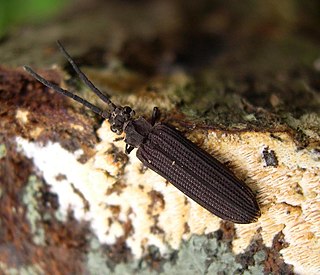
The Archostemata are the smallest suborder of beetles, consisting 45 living species in five families. They are an ancient lineage with a number of primitive characteristics. They are similar in morphology to the first beetles, which appear in the fossil record about 250 million years ago. Antennae may be thread-shaped (filiform) or like a string of beads (moniliform). This suborder also contains the only beetles where both sexes are paedogenic, Micromalthus debilis.

Myxophaga is the second-smallest suborder of the Coleoptera after Archostemata, consisting of roughly 65 species of small to minute beetles in four families. The members of this suborder are aquatic and semiaquatic, and feed on algae.
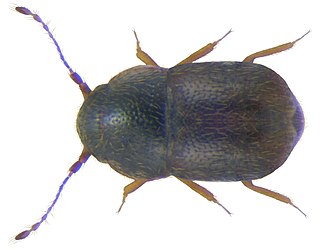
Baeocrara is a genus of featherwing beetles named because of the intricate structure of their flight wings, which have a long fringe of hairs on their borders. They belong to the Ptiliidae family, and are minute: between 1 and 0.5 mm. They are mostly found in hollow fir stumps and other types of rotten wood, dung and plant detritus. They feed on fungal spores. They seem to be recent immigrants to Northern Europe possibly introduced by the import of sawmill products. They have been reported in the Czech Republic. They are one of the least known groups in the Coleoptera.
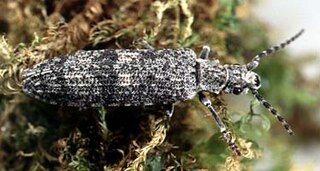
Priacma is a genus of beetles in the family Cupedidae. It contains a single extant species, Priacma serrata native to western North America and one fossil species, P. megapuncta from the Cenomanian aged Burmese amber. Species previously assigned to the genus from the Yixian Formation of China have been subsequently placed in the separate genus Apriacma.
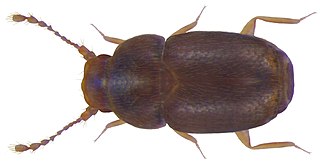
Pteryx is a genus of beetles that is typically found in northern bogs in the Northern Hemisphere. They belong to the family Ptiliidae which is referred to as feather-winged beetles as the hindwings are narrow and feather-like. Like most of the rest of the family, Pteryx are very small and live in rotting vegetative matter. They prefer rotting wood and are generally found under the bark of rotting logs or stumps.
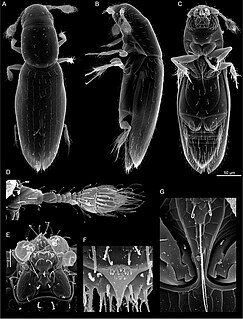
Scydosella is a genus of beetles that consists of only one species Scydosella musawasensis. The species is regarded as the smallest free-living insect, as well as the smallest beetle. They are among featherwing beetle, named because of their feather-like spiny wings. It was first discovered in Nicaragua, and described in 1999 by Wesley Eugene Hall of the University of Nebraska State Museum. The initial discovery consisted of very few specimens, and exact measurements were not conclusive. Because of their tiny size, they were difficult to observe under microscope after preservation. The generally accepted size was 0.300 mm in length. On 8 February 2015, Alexey Polilov of the Lomonosov Moscow State University collected 85 specimens in Chicaque National Park, Colombia. They were discovered on a layer of fungus on which they feed. From these specimens exact measurements could be made, and was found that the smallest individual is only 0.325 mm long. The largest individual is 0.352 mm long, and the average length of all the specimens is 0.338 mm. The body is elongated and oval in shape, yellowish-brown in colour, and its antennae are split into 10 segments.
Discheramocephalus brucei is a species of feather-winged beetle, the smallest beetles on earth, first found in Cameroon.
Discheramocephalus elisabethae is a species of feather-winged beetle, the smallest beetles on earth, first found in Cameroon.
Discheramocephalus mikaeli is a species of feather-winged beetle, the smallest beetles on earth, first found in Tanzania.
Discheramocephalus stewarti is a species of feather-winged beetle, the smallest beetles on earth, first found in Bolivia.
Discheramocephalus jarmilae is a species of feather-winged beetle, the smallest beetles on earth, first found in Bolivia.
Discheramocephalus minutissimus is a species of feather-winged beetle, the smallest beetles on earth, first found in Indonesia. This species' adults have a body length of approximately 400 to 426µm. According to Grebennikov, the main factor limiting miniaturisation of female insects is an egg size significant enough in size to produce viable larvae. This size threshold is sometimes overcome, reaching limits of 180 and 130 µm in females and males, respectively, according to the author. Brain size is possibly the second most important factor limiting miniaturisation in this class.

Baranowskiella is a genus of beetles in the Ptiliidae family.
Sceptobius is a genus of rove beetles in the family Staphylinidae. There are at least three described species in Sceptobius.
Dinardilla is a genus of rove beetles in the family Staphylinidae. There are at least two described species in Dinardilla.
Discheramocephalus is a genus of feather-winged beetles, the smallest beetles on earth, first found in Cameroon. It was originally described in 2007 as a monotypic genus. Six additional species were added in 2008, and two were added in 2013.
Discheramocephalus semisulcatus is a species of feather-winged beetle, the smallest beetles on earth.

Cyclaxyridae are a family of beetles in the superfamily Cucujoidea. The only living genus is Cyclaxyra, with two species endemic to New Zealand. Other species have been named from fossils. They are also known as sooty mould beetles due to the association of Cyclaxyra with sooty mould. The extant species are mycophagous, feeding on spores, conidia, and hyphae.
2018 in paleoentomology is a list of new fossil insect taxa that were described during the year 2018, as well as other significant discoveries and events related to paleoentomology that were scheduled to occur during the year.
Burmese amber is fossil resin dating to the early Late Cretaceous Cenomanian age recovered from deposits in the Hukawng Valley of northern Myanmar. It is known for being one of the most diverse Cretaceous age amber paleobiotas, containing rich arthropod fossils, along with uncommon vertebrate fossils and even rare marine inclusions. A mostly complete list of all taxa described up until 2018 can be found in Ross 2018; its supplement Ross 2019b covers most of 2019.








